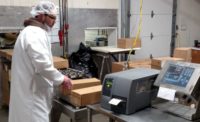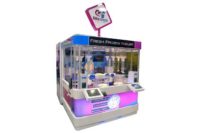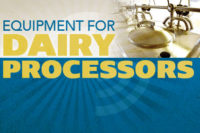At the Plangger organic cheese dairy in the Austrian Tyrol region, a Stäubli six-axis robot is busy de-rinding and coating irregularly shaped blocks of cheese, a demanding job that calls for maximum resilience. The TX2-90 humid environment (HE) is able to withstand intensive cleaning with aggressive detergents delivered by a high-pressure lance — the sort of treatment that would soon spell the end for the average standard robot.
At any one time, up to 650 tons of organic cheese made with milk from Tyrolean hay-fed cows are maturing in the 160-meter-long, 10-meter-high man-made cave of the Plangger cheese dairy in Niederndorf, Austria. The cave, which was blasted out of the rock face in 2015, is crucial to the running of this organic cheese dairy, which prides itself on the production of quality food in harmony with nature.
The commitment of the family-run business with its 40-strong workforce begins well before inputting the basic raw material, milk. Plangger works with its farmers and Alpine dairymen to ensure optimized natural soil structures. Traditional knowledge, the use of effective microorganisms and long maturation under the special climatic conditions conferred by natural rock give the hard cheeses in Plangger’s product range a taste so unique that customers from as far away as Germany make a pilgrimage to this part of the Inn Valley.
Smart automation
“Production in harmony with nature” is no longer synonymous with “exclusively handcrafted,” however. “In order to increase our productivity and optimize variety, we have been automating certain production processes in recent years,” explains Reinhard Brunner, master cheesemaker and junior manager of Plangger. “We have opened up additional capacity while keeping the workforce at the same size as before. At the same time, we have been able to relieve our employees of ergonomically and climatically demanding work. For example, we have three waxing robots working 24 hours a day in the cave, where the temperature is a constant 11 degrees Celsius.”
Since early March 2020, two additional otherwise strenuous activities have been carried out in a fully automated robot cell. Here, a ceiling-mounted Stäubli TX2-90 HE has taken over the entire de-rinding of cheeses, as well as the coating of Sennkäse cheeses.
“Some of our customers, mainly German bulk buyers, prefer hard cheeses without the rind on. In the past, the hard rind was removed manually with a scraping iron. This took about 10 minutes per 600-millimeter block and required immense physical effort from the employee. Today, the robot does the job more accurately and economically than ever before,” says Brunner.
Hygiene standards perfectly met
The already stringent standards that apply in the food sector are taken to an even higher level in cheese production, given the deliberate use of bacteria. Cleaning at the Plangger plant is carried out with fat-dissolving, alkaline and milkstone-dissolving acidic agents, as well as water heated to 55 degrees Celsius. The robot cell, which must withstand cleaning procedures several times a week, was installed in compliance with current hygiene standards by Schwaz, Austria-based company Dessl Maschinenbau.
“Both tasks — paring away the outer layer evenly and applying an herb-rock salt coating — have the potential for causing major contamination,” explains Julian Bstieler, technical manager at Dessl Maschinenbau. “For this reason, optimum cleaning was a key factor in the design of the plant. Stäubli’s six-axis HE robots are HACCP-certified, and their hygiene concept is unique, as they can manage without additional protective covering even in environments where they are heavily exposed to moisture.
“There is no other truly viable alternative to using these robots in combination with H1 oil, which is the only kind approved for direct food contact,” Bstieler continues. “In designing and installing systems for cheese dairies, we have, therefore, used this type of robot exclusively for a number of years now.”
Custom-built for cheese rounds
The overall configuration of the cell also follows the principle of easy cleaning. The cell’s dimensions allow enough space for a human operator to work comfortably inside. All cable feeds for the ceiling-mounted robot are on the outside of the cell.
“Only the power supply for the electric spindle on the robot hand had to be routed externally,” says Bstieler. “Moreover, we dispensed with sensitive sensor technology inside the cell, the only exception being the laser distance meter. This has resulted in high availability since the system was commissioned in March 2020.”
The first step of the process is paring the top and perimeter. The cheese is automatically lifted from the belt and placed on a rotary table equipped with a vacuum-suction unit. The robot does not begin its work until the cheese has been measured by laser, since the blocks are irregular in shape and no two are ever identical. The paring tool can then begin to remove the rind. The Stäubli control system adjusts the distance between the cutter and the surface in real time.
When the moment comes for the underside to be de-rinded, the handling unit grips the cheese at the center, swivels it around and places it on the second rotary table. Here, it is measured by laser again before the final stage of de-rinding can proceed. the block then is lifted and placed on the discharge conveyor belt.
Three-dimensional path tracking
“Compared to manual processing, we achieve a much more even de-rinding with the robot, which has the additional benefit of less waste,” says Brunner.
The precision of the three-dimensional path tracking during the paring process is crucial, with the distance-measuring laser function on the robot arm and the rigidity of the six-axis machine playing especially important roles.
The sensor technology was a challenge for the plant engineers.
“The laser cannot be allowed to get dirty during the machining process. Further, we cannot have any loose fragments hanging from the block, as these would falsify the readings and so change the cutting depth,” explains Bstieler. “The in-house development of a paring tool with defined edges for ejecting fragments was particularly time-consuming.”
The minimization of waste in the de-rinding process and much reduced cycle time have more than justified the system’s acquisition.
“Our original intention to automate the de-rinding has been very successful,” Brunner says. “In addition, we saw during the development phase that the system can also take on other jobs very flexibly. So with the addition of coating for our Sennkäse variety, the Dessl Maschinenbau team implemented not one, but two applications for us.”
Tool changing takes no longer than about 10 minutes and is mainly a matter of switching the grippers and vacuum plates to accommodate the smaller cheese diameters. Because the paring tool is firmly mounted on the robot arm, the Stäubli TX2-90 HE needs only a brush to be placed in its hand, and it will perform the job of cheese coating without complaint. With a cycle time of around 20 seconds, there are always a few splashes, but this is where the regular cleaning routines come in.





